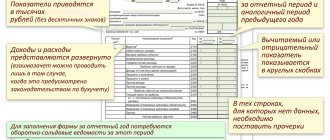What accounting requirements must be met so that high-quality financial statements can be generated on its basis?
When preparing financial statements, companies must proceed from the fact that such statements must give a reliable picture of its financial position as of the reporting date, financial results and cash flows for the reporting period, which are necessary for users of these statements to make economic decisions (Article 13 of the Federal Law dated December 6, 2011 No. 402-FZ “On Accounting”).
The preparation of financial statements begins with checking the correctness of the generated turnovers and balances in the accounting accounts.
And in order for financial statements to be reliable, it is necessary to comply with accounting requirements. After all, if the turnover is formed in accordance with the current accounting standards and accounting policies of the company, and the accounting program provides the necessary detail (analytics) of the accounts, then the preparation of financial statements is, in fact, a technical work.
Important! In many 1C software products there is an express check of accounting and analysis of the state of accounting. One of the purposes of such checks is to analyze accounting results, the presence of account balances that must be distributed, etc.
However, in a number of non-standard, complex business transactions, it would be useful for an accountant to trace the movement in the accounts of synthetic and analytical accounting and evaluate the correctness of the formation of the corresponding line of accounting statements.
Composition of the annual financial statements 2016
The annual financial statements of commercial companies must include:
- Balance sheet;
- Statement of changes in equity;
- Cash flow statement;
- explanatory notes to the balance sheet and reports;
- auditor's report - if the organization is subject to mandatory audit.
Statement of financial results (profit and loss statement);
The forms of the balance sheet and the above-mentioned reports were approved by Order of the Ministry of Finance of Russia dated July 2, 2010 No. 66n.
Attention! Insurance and credit organizations have their own reporting forms. For more information about them, see the relevant paragraphs of this reference material.
Why is it necessary to evaluate balance sheet items?
The preparation of a balance sheet, as well as other reports included in accounting, is subject to a number of specific requirements and rules.
Such rules also include a method for assessing the amount that will fall into a specific line of the balance sheet, regardless of whether it is located in its assets or liabilities. ATTENTION! From 2022, financial statements will be submitted exclusively in electronic form. Paper forms will no longer be accepted. Read more about changes to the rules for presenting financial statements here. We also remind you that in 2022 the reporting forms have been updated.
Knowledge of the rules and methods for valuing balance sheet items helps to correctly formulate all the amounts on the balance sheet lines.
For more information about what requirements apply to the balance sheet, read the article “What requirements should accounting records satisfy?” .
Deadlines for submitting annual reports
Article 23 of the Tax Code of the Russian Federation states that organizations are required to submit annual financial statements to the Federal Tax Service no later than March 31 of the year following the reporting year.
If March 31st falls on a Saturday or Sunday, then you can submit reports on the following Monday. In 2022, this day falls on a Friday, so there will be no postponement.
Since you can submit a report in different ways, the question arises of how exactly the date of submission of the report will be calculated:
- If the reporting is sent by mail in a valuable letter with a description of the attachment, this date is considered the day of its mailing. It is indicated on the postmark placed by the postal worker on the inventory of the attachment.
- If the reporting is submitted in person, this date is considered to be the date of its submission. The tax officer must indicate this date on a copy of the reporting or a copy thereof, which remains with the taxpayer. The date is put together with a signature from an employee of the Federal Tax Service, confirming that the tax authority has received a report from the organization.
- If the reporting is submitted electronically, the date of dispatch is considered to be the date indicated in the confirmation of dispatch, i.e. in an electronic document generated by a telecom operator or tax authority.
IMPORTANT! There is no need to submit interim accounting reports (for a quarter or a month) to the tax office.
What errors are considered significant and subject to correction?
If an error can affect the correct decisions made by users, it is significant. Such an error violates the requirements for the content of financial statements and must be corrected. The level of materiality is established by the business entity independently and is fixed in the accounting policy. Established practice suggests taking the materiality level at 5% of the amount of the reporting item in which there was an inaccuracy.
How to correct a significant error in accounting
| Moment of error detection | Correction procedure |
| Before signing | In December of the year for which it is compiled, a reversing entry. The correction is taken into account when generating accounting reports |
| After signing but before approval | In December of the year for which the accounting reports are compiled, a reversing entry is made. An updated accounting report is compiled and presented to all users |
| After approval | In the month of discovery, an adjusting entry was made in correspondence with account 84 “Retained earnings (uncovered loss).” Accounting statements of previous years are not adjusted |
PBU and IFRS
PBU and IFRS are accounting standards. What is the difference?
PBU is an abbreviation for “Accounting Regulations”. These are Russian accounting standards that regulate the accounting of assets, liabilities or events of economic activity. PBUs are internal documents of Russia, they are adopted by the Ministry of Finance of the Russian Federation and are valid for commercial non-banking organizations (for banks and credit organizations, the provisions adopted by the Central Bank of the Russian Federation are used).
Today there are 24 PBUs in force, all of them are mandatory for use when preparing financial statements and maintaining accounting registers.
IFRS is an abbreviation for International Financial Reporting Standards. These standards are adopted by the International Accounting Standards Board (IASB), located in the UK.
IFRS is mandatory for use in some European countries, as well as for almost all European companies whose securities are traded on the stock exchange.
In Russia there is a program for reforming accounting in accordance with IFRS. By Order of the Ministry of Finance of Russia dated November 25, 2011 No. 160n, 63 documents were put into effect in our country: the IFRS standards themselves and explanations to them.
Basic requirements for accounting
Legislative acts establishing the basic requirements for financial statements are Federal Law No. 402-FZ dated December 6, 2011 and PBU 4/99, approved by Order of the Ministry of Finance dated July 6, 1999 No. 43n. Based on accounting records, users make economic decisions. In order for these decisions to be correct, the following requirements apply to the preparation of financial statements:
- Completeness. Accounting statements reflect data based on all facts of the company’s economic life for the reporting period. The information contained herein provides a complete picture of changes in financial position and results of operations.
- Consistency means that the forms and content of accounting are applied consistently each reporting period. This makes it possible to compare data.
- Reliability assumes that, based on the data obtained, it is possible to draw correct conclusions about the financial position and performance of the organization.
- Materiality. All data that could influence user decision-making is subject to disclosure.
- Utility. There is no need to include information that does not influence decisions made. All data must be relevant, timely, reliable and comparable.
- Neutrality of accounting statements implies that distortion of data in the interests of one group of users is excluded. All information is reflected so that any user can make the right conclusions.
Forms of financial statements of commercial organizations
- Balance sheet (form 071001) - consists of 5 sections: Non-current assets, Current assets, Capital and reserves, Short-term and Long-term liabilities. The balance sheet form is filled out line by line, each line contains the indicators as of the reporting date of the reporting period, as of December 31 of the previous year and as of December 31 of the previous year.
- Statement of financial results (report and profit and loss) - form 0710002. It reflects information on the organization’s income and expenses, as well as its profits and losses for the reporting period and the same period of the previous year (this is established in PBU 4/99).
- Statement of changes in capital (form 0710003) - shows the movement of the organization’s capital for the reporting year and the two previous years.
- Cash flow statement (form 0710004) - shows the flow of cash and cash equivalents in the organization for the reporting year and the previous year.
- Explanatory note to the Balance Sheet and the Financial Results Report - these documents can be formatted either as a table or as text. In the case of a table, the organization itself determines the content of these explanations.
All these forms of financial statements, as well as the procedure for filling them out, were approved by Order of the Ministry of Finance of Russia dated July 2, 2010 No. 66n.
Small businesses also use the Balance Sheet and Financial Results Report forms approved by the same order of the Ministry of Finance.
What is taken into account when assessing balance sheet sections
The operations carried out in the company are associated with many accounts reflected in the balance sheet liability or in the asset: for settlements (with the budget, counterparties, personnel), property, monetary, taking into account the movement of capital.
The balance sheet asset includes sections I and II, reflecting in monetary form the assets belonging to the business entity, taking into account their composition and location.
In section I of the asset (“Non-current assets”), long-term assets are subject to assessment:
- Intangible assets accounted for at the valuation balance. The remainder value is formed as the difference between the initial, i.e. restoration, assessment and size of wear determined by object.
- Fixed assets accounted for similarly to intangible resources, except for plots of land for which depreciation is not provided.
For your information! In the balance sheet, all types of intangible assets and fixed assets, without taking into account the place and other characteristics of their use, are concentrated in a single section.
- Financial investments are long-term, reflecting the use of the enterprise’s property or its monetary resources in other economic structures, with the investment period ranging from 12 months.
- Capital investments representing the real expenses of the enterprise on unfinished construction projects.
Section II, which combines current assets, contains current assets, divided into subgroups:
- “Inventories”, which includes current assets of the company’s production sector for individual items. In the balance sheet, the assessment of materials and raw materials is carried out at real cost, expenses for unfinished production are formed according to production costs, standard ones, or the amount of direct expenses.
For your information! This section also includes items of circulation that are accounted for in the form of a finished product, shipped commodity mass, and future expenses, estimated at actual cost.
- “Cash”, where financial investments are concentrated in other enterprises for a short time. This subgroup also contains accounts intended for accounting for funds at the enterprise's cash desk, in its bank (settlement, currency) accounts, other types of funds, as well as debts of debtors (company employees, other organizations or individuals).
The balance sheet liability, including sections III, IV, V, reflects in monetary terms the attracted and own sources of resources of the enterprise, directed towards the formation of its property.
In Section III (“Capital and Reserves”), the company’s own sources for the formation of the company’s property are concentrated in the form of separate articles. It also takes into account the subject’s uncovered damage and its retained earnings.
For your information! If the founder's share is not paid in full, the amount of debt on the balance sheet is shown separately.
Section IV, associated with long-term obligations, accumulates the company’s debts for funds raised from banking and other structures, while the time of attraction is more than 12 months.
Section V, which includes short-term liabilities, accumulates different groups of short-term debts the company has in the form of borrowed funds, debts of creditors, revenues for upcoming periods, and reserves for future expenses.
Accounting report and accounting in a simplified manner
Law 402-FZ on accounting allows some organizations (including small businesses) to maintain accounting records and submit reports in a simplified manner. At the same time, these organizations have the right to prepare financial statements in accordance with the generally established procedure. The corresponding decision is made by organizations independently.
According to a simplified scheme, they can keep records:
- Participants of the Skolkovo project.
- Small businesses.
- Non-profit organizations.
The law specifically stipulates who does not have the right to conduct simplified accounting and submit simplified reporting. This:
- organizations whose financial statements are subject to mandatory audit;
- Housing complexes, housing cooperatives and microfinance organizations;
- credit consumer cooperatives;
- state organizations;
- political parties;
- bar associations, law offices, chambers and consultations;
- notary chambers;
- non-profit organizations performing the functions of a foreign agent.
Accounting and reporting of small businesses
The criteria for classifying companies as small enterprises are specified in Article 4 of Federal Law No. 209-FZ dated July 24, 2007. The main ones: number of employees - no more than 250 people, annual income - no more than 2,000,000,000 rubles, participation share of other legal entities in the authorized capital (there are several options).
Small businesses only submit a Balance Sheet and a Statement of Financial Results. They are also given the right to add financial indicators to the report only for groups of items without detail.
As for the simplified methods of accounting, they are all listed in Information of the Ministry of Finance of Russia No. PZ-3/2015. This:
- Keeping records without double entry.
- Abbreviated chart of accounts.
- Simplified system of accounting registers.
- Possibility not to apply some PBUs.
- Cash method of accounting for income and expenses.
- Valuation of financial investments at their original cost (that is, without subsequent revaluation).
- And some other details.
Accounting and reporting of Skolkovo participants
Accounting and reporting for this category of companies are subject to the same rules that apply to small businesses.
Accounting report of non-profit organizations
Simplified methods of accounting for non-profit organizations are listed in Information of the Ministry of Finance of Russia No. PZ-1/2015 (this letter applies only to non-profit organizations!). They generally repeat the same rules that are established by Information of the Ministry of Finance No. PZ-3/2015 for small enterprises (see above in the text), with some minor changes.
The annual accounting report of a non-profit organization consists of a balance sheet, a report on the intended use of funds and appendices thereto.
The Report on the targeted use of funds discloses information about the receipt of funds by the NPO intended to support its statutory activities, and about the targeted use of these funds in accordance with the approved budget or financial plan. The report also contains data on the balance of these funds at the beginning and end of the reporting period (year).
The form in which NPOs prepare this report can be of two types:
- generally established form 0710006
- simplified form 0710006.
The second, simplified, can be used by those non-profit organizations that keep records according to a simplified scheme (they have the right to do this according to Law 402-FZ).
The first, general one, is used by all others. Or, if desired, “simplified” people can also use it.
Both forms were approved by Order of the Ministry of Finance of Russia dated July 2, 2010 No. 66n.
Accounting statements of budgetary organizations
The reporting of budgetary, autonomous and government institutions is regulated by separate regulations. It differs from the reporting of commercial companies. Moreover, this reporting is also different for different types of budgetary institutions, although it has similar principles and features.
Budgetary and autonomous institutions draw up and submit financial statements in accordance with the Instructions on the procedure for compiling and submitting annual and quarterly financial statements of state (municipal) budgetary and autonomous institutions, approved by Order of the Ministry of Finance of Russia dated March 25, 2011 No. 33n.
government institutions are guided by another document - the Instruction on the procedure for compiling and submitting annual, quarterly and monthly reports on the execution of budgets of the budget system of the Russian Federation, approved by Order of the Ministry of Finance of Russia dated December 28, 2010 No. 191n.
General reporting requirements for budgetary, autonomous and government institutions are as follows:
- Reporting is prepared based on the results of the calendar year.
- The data reflected in the statements must be confirmed by the results of the inventory of assets and liabilities.
- The report must be signed by the manager and chief accountant and can be submitted both on paper and electronically.
Reporting must be submitted in the following forms:
- Institutional balance sheet (form 0503730 - for budgetary and autonomous, form 0503130 - for government institutions)
- Certificate on consolidated settlements (form 0503710 - for budgetary and autonomous, form 0503125 - for government institutions)
- Certificate for the conclusion of budget accounting accounts (form 0503725 - for budgetary and autonomous, forms 0503110 and 0503111 - for government institutions)
- Report on the execution of the plan/budget (form 0503737 - for budgetary and autonomous, forms 0503127, 0503317 and 0503117 - for government institutions)
- Report on the obligations assumed by the institution (form 0503738 - for budgetary and autonomous, form 0503128 - for government institutions)
- Report on financial results of activities (form 0503721 - for budgetary and autonomous, form 0503121 - for government institutions)
- Explanatory note (form 0503760 - for budgetary and autonomous, form 0503160 - for government institutions)
- Certificate of amounts of consolidated revenues to be credited to the budget account (form 0503184 - only for government institutions)
- Balance of budget execution (form 0503120 - only for government agencies)
- Cash flow statement (form 0503123 - only for government institutions)
- Report on cash receipts and outflows of funds (form 0503124 - only for government institutions)
- Separation balance sheet (form 0503230 - only for government institutions)
- Consolidated statement of financial results (form 0503321 - only for government institutions)
- Consolidated cash flow statement (form 0503323 - only for government institutions)
Accounting statements of banks and credit organizations
The accounting statements of banks and credit institutions are special. It is regulated by the regulatory documents of the Bank of Russia. The fundamental documents are the “Regulations on the rules of accounting in credit institutions located on the territory of the Russian Federation” (approved by the Bank of Russia on July 16, 2012 No. 385-P) and the Bank of Russia Directive dated September 4, 2013 No. 3054-U “On the procedure for drawing up credit organizations annual accounting (financial) statements.” Attention!
New reporting forms for banks were established by Bank of Russia Directive No. 4212-U dated November 24, 2016, which canceled the previously effective Bank of Russia Directive No. 2332-U dated November 12, 2009.
New reporting forms include:
- 0409120 “Data on the risk of information for calculating the amount of participation of foreign capital in the total authorized capital of credit institutions licensed to carry out banking operations”;
- 0409702 “Information on unexecuted transactions”, developed for the purpose of maintaining statistics and operational monitoring of systemic risks of the financial system associated with the non-execution of certain types of transactions in financial markets.
The requirements for the formation of indicators of reporting forms and the procedure for their submission to the Bank of Russia are also clarified.
Annual reporting of banks is compiled based on the results of the calendar year. It is subject to mandatory audit. The auditor's report is submitted along with the annual report to the Bank of Russia.
Requirements for preparation of financial statements
As mentioned above, financial statements must be kept in Russian, in Russian currency and on standard forms.
In addition, each component of the overall report must contain:
- Name;
- reporting date or indication of the period for which it is compiled;
- name of the enterprise and its details;
- format of presented numerical indicators of financial statements.
The financial statements are signed by the head of the enterprise and the person who compiled it (as a rule, this is the chief accountant of the enterprise). Any errors or corrections found must be confirmed by the date and signature of the person who corrected them.
Was the information interesting or useful?
Yes48
No9
Share online
Audit of financial statements
In a number of cases, the law establishes that an organization is required to conduct an audit of its financial statements. The list of cases when this is mandatory is established by Federal Law No. 307-FZ of December 30, 2008 “On Auditing Activities”. In particular, an audit is required:
- for all JSC (joint stock company);
- for companies whose securities are admitted to organized trading;
- for credit institutions, funds, securities market participants, insurance and clearing companies;
- for gambling organizers and lottery operators;
- for SROs (self-regulatory organizations);
- for state companies and corporations;
- for a number of specific companies (Rostec, Rosatom, Deposit Insurance Agency, Roscosmos, etc.);
- and also if the volume of revenue from the sale of products (goods, works, services) of the organization for the previous reporting year exceeds 400 million rubles or the amount of balance sheet assets as of the end of the previous reporting year exceeds 60 million rubles;
The auditor's report is not included in the annual financial statements, but is attached to it. The organization is obliged to submit the audit report to the state statistics body and publish it along with its annual reports.
Inventory
Before preparing annual financial statements, the organization is required to conduct an inventory. This obligation applies to all companies, regardless of their tax regime or legal form. The purpose of inventory is to ensure the reliability of accounting data and financial statements. To do this, during the inventory, the presence, condition and assessment of the organization's assets and liabilities are checked and documented.
This inventory is planned. To carry it out, the manager must approve the inventory regulations. The timing of such an inventory is from January 1 to December 31 of the reporting year.
An annual inventory is carried out on all assets and liabilities of the company, the verification is complete.
There are other reasons for conducting an inventory, unscheduled. They are established by the Regulations on accounting and financial reporting, Federal Law 402-FZ and PBU 4/99). This:
- change of financially responsible persons;
- identification of facts of theft, abuse or damage to property;
- natural disasters, fire or other emergencies;
- liquidation or reorganization of an organization.
Inventory procedure
- Step 1. Creation of an inventory commission
- Step 2. Receiving the latest incoming and outgoing documents
- Step 3. Receiving a receipt from the financially responsible person
- Step 4. Preparation of inventory records (acts)
- Step 5. Verification and documentary evidence of the presence, condition and valuation of assets and liabilities
- Step 6. Summarizing the results identified by the inventory
- Step 7. Approval of inventory results
- Step 8. Reflection of inventory results in accounting
You can read more about these stages in the “Practical guide to annual financial statements 2016” of the Consultant Plus system.
Interim reporting
Interim accounting (financial) statements are prepared for the period from January 1 to the reporting date of the period inclusive. That is, it could be a month, a quarter, 9 months, and possibly any other period of less than a year (Part 5, Article 13 of Law No. 402-FZ “On Accounting”).
The obligation to prepare interim financial statements is established by Part 4 of Article 13 of Law No. 402-FZ “On Accounting”. Interim reporting is prepared in the case when legislation, the constituent documents of the company or decisions of the owner of the company establish the obligation to submit it.
Currently, there is no obligation for companies to submit interim reports to government agencies. Therefore, it is necessary to draw up it if such a requirement is recorded in the constituent documents or by decision of the business owners.
We prepare an annual report with Consultant Plus
The developers of the legal reference system Consultant Plus traditionally publish an annual analytical material, “A Practical Guide to Annual Accounting Reports.” This material usually includes very detailed explanations about the formation of an accounting report for the year, with examples, comments, samples of filling out document forms, etc.
The unique tool contained in this material, the “Interconnection of indicators” section, will help you once again check your finished report for the correctness of the details.
Read more about the Practical Guide to the Annual Report from Consultant Plus.






